
Stained glass windows
in St Andrew's Chapel:
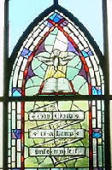
Religion
General
Pembroke Dock developed in the nineteenth century, when churches and chapels were centres for Sunday services, Sunday schools,
and a range of cultural and leisure activities. Chapels were, in the words of Prof. Anthony Jones, the "religious, social, educational
and musical and entertainment centres of each community".
Church of England services were first held in the beached HMS Lapwing, and in a wooden building. The Dockyard Chapel was erected
around 1831. St. John's was completed in 1848, and the smaller "mission" churches of St. Patrick's (Pennar) and St. Teilo's (Llanion) in
1896 and 1903.
Chapel development followed a similar pattern. Congregations would often use a private house or a rented room until they could
afford to build a chapel. Much of the building work would be voluntary, using the shipbuilders' skills in carpentry and joinery. Masonry
and plastering tended to be left to paid specialists.
Money for these chapel projects, and for rebuilding and improvements, was raised by collections, bazaars and concerts. In the late
1830s the Rev. John Davies of Gershom Chapel even "travelled the country far and near soliciting subscriptions... To curtail his
expenses he would walk through the streets of London munching a penny bun, and living on the most frugal fare". Grants could assist
the Church of England - but fundraising and voluntary work were essential for the established church, too.
George Mason catches the atmosphere inside the town's first chapel, Bethany, in the early days. "The choir was led by a band
composed of violins, cello, double bass and flute. The lighting of the chapel consisted of dip tallow candles". The candle wicks
needed frequent adjustment, "a disturbing operation to the elders of the congregation but a relieving diversion for the children, who
watched the operator ascend the pulpit where the minister had to stand aside to allow the candles to be snuffed".
As the town grew, congregations became larger Reported attendance figures at Wesley, for example, on a sample Sunday in 1851
were: morning, 389 + 191 scholars - evening, 545 + 80 scholars.
Larger buildings replaced the some of the smaller early chapels. Wesley (1848-) and the Tabernacle, Albion Square (1867) could
accommodate 1300 each. More ornate and imposing architecture replaced the simpler styles of early chapels. Gas lighting took over
from candles. Harmoniums, then organs, replaced string and wind ensembles.
By the end of the twentieth century, with many alternative activities, attendance had declined drastically.
...
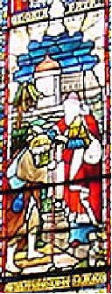
.

(Sources: Jones, Anthony, 46 - Jones, Ieuan 399 - Mason 148, 151, 166, 176, 204-5, 212-3, 187, Peters 100; )
Pictures by courtesy of St Andrew's Presbyterian Church.
Religion - Some clergymen
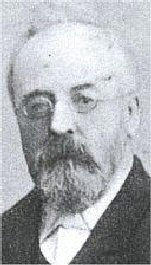
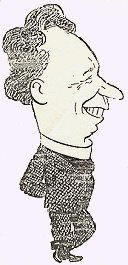
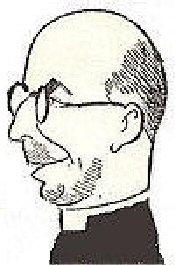
Rev. R. C. Roberts of Bethel
1876-1913, affectionately
remembered as "The Uncle of
Pembroke Dock.
Rev. Lestyn Jenkins of St. Andrew's & Fr Ivor Daniel, two of the town's personalities in the
1920s, by Matt.
Pictures: Rev. R.C. Roberts, Roberts, R.C. - Rev. Iestyn Jenkins & Fr I. Daniel, Matt, Sunday Graphic

Religion- Churches & chapels - interior details.
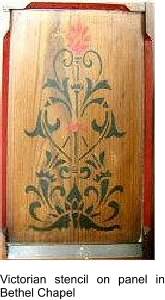

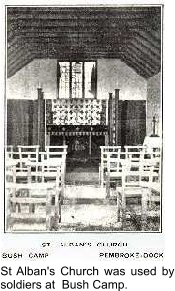
Pictures by courtesy of: Bethel chapel, with photographs by Mrs Gwen Griffiths - St Alban's, private collection.

Religion - Outdoor services
|
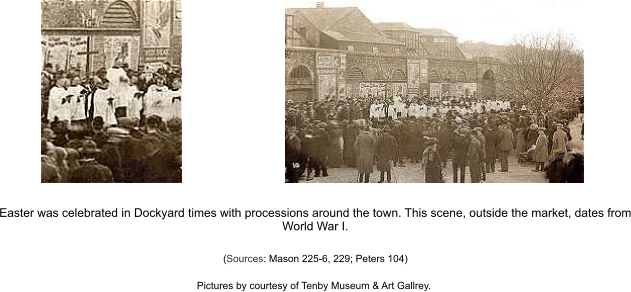
Some early clergymen were obliged to address their hearers in the open air, because indoor facilities were not ready. Father Lewis would
regularly preach at the top of Pembroke Street, before St Mary's Roman Catholic Church was built .
The Rev. Thomas Davies Mathias of Gilgal held outdoor baptisms in the 1860s. These were "striking events ... a sight to be remembered", with
people "wending their way ... to the beach at Lower Pennar, until over a thousand would congregate to witness the impressive scene, much
enhanced by the singing of those belonging to the little chapel assembled at the edge of the water". Gilgal chapel acquired an indoor baptistery
in 1867.
Later, some services were held outdoors by choice. The Salvation Army conducted meetings in the streets and on the Barrack Hill, as well as
indoors.

Religion - Places of worship: building dates
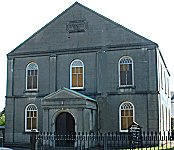
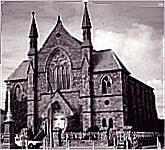
Chapel buildings - simple (Trinity, Meyrick Street)
... and more ambitious (Tabernacle, Albion Square)
Religion - Visitors

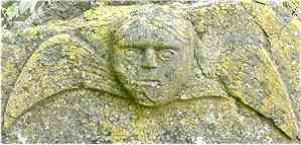
This angel adorns a headstone in Park Street cemetery.
Pembroke Dock's churches and chapels have welcomed many visitors, as well as natives of the town. In Dockyard, Army and RAF days, church parades
were a part of civic life. In World War II, St Mary's Roman Catholic Church had congregations of allied servicemen, including free Poles. Vernon Scott
recounts the story of "German and Italian prisoners of war attending regularly at St. Mary's .... during one Christmas midnight mass a choir - made up
entirely of German POWs - sang Silent night in German"
Notable preachers, as well as worshipers, visited the town. One of the most memorable was "Nar-Kar-Wa, (Flying Cloud), "a celebrated American Baptist
preacher, formerly an Indian chief of the Mohawk tribe". In 1873, Flying Cloud attracted large congregations in Wesley and Albion Square. He also
"delivered a lecture in full costume as an Indian chief. His dexterity in handling the club and tomahawk was remarkable"
Notable in a more traditional way was General Booth, who in 1886 preached in Albion Square Chapel "to an immense congregation, when many could not
get in". At earlier Salvation Army services "the platform teemed with ... unmistakably changed people, who were anxious to tell others of their new
found happiness".
(Sources: Scott, Catholic community .. ; Mason 204, 229 )
Pembroke Dock's churches and chapels have welcomed many visitors, as well as natives of the town. In Dockyard, Army and RAF days, church parades
were a part of civic life. In World War II, St Mary's Roman Catholic Church had congregations of allied servicemen, including free Poles. Vernon Scott
recounts the story of "German and Italian prisoners of war attending regularly at St. Mary's .... during one Christmas midnight mass a choir - made up
entirely of German POWs - sang Silent night in German"
Notable preachers, as well as worshipers, visited the town. One of the most memorable was "Nar-Kar-Wa, (Flying Cloud), "a celebrated American Baptist
preacher, formerly an Indian chief of the Mohawk tribe". In 1873, Flying Cloud attracted large congregations in Wesley and Albion Square. He also
"delivered a lecture in full costume as an Indian chief. His dexterity in handling the club and tomahawk was remarkable"
Notable in a more traditional way was General Booth, who in 1886 preached in Albion Square Chapel "to an immense congregation, when many could not
get in". At earlier Salvation Army services "the platform teemed with ... unmistakably changed people, who were anxious to tell others of their new
found happiness".
(Sources: Scott, Catholic community .. ; Mason 204, 229 )

TOP
HOME
Thy Word is a Lamp
unto my feet God's
messenger and the
Prodigal Son.
,
(Amendment, updates and additions) (AJ) Anndra Johnstone
This site is designed, published and hosted by CatsWebCom Community Services © 2018 part of Pembroke Dock Web Project


































